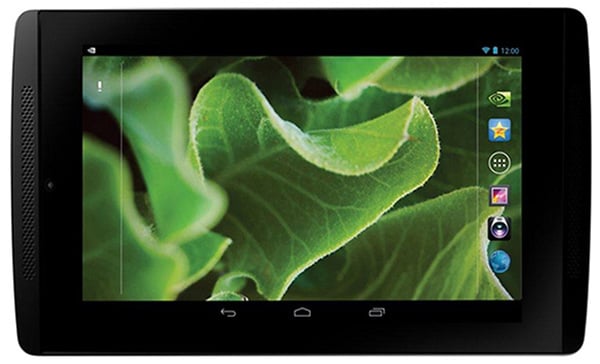EVGA Tegra Note 7 Android 4.3 Tablet Review
Design and Exterior
The EVGA Tegra Note 7 is similar in size and weight to other like-sized tablets. The device’s overall dimensions are 7.83 x 4.68 x 0.37 inches and it weighs in at 11.2 ounces. Powering the device is an NVIDIA Tegra 4 SoC (quad-plus-one-core) with a 72-core GeForce GPU and 1GB of RAM. There is also 16GB of internal storage, though that is expandable.
The backside and surrounding frame of the Tegra Note are made of a black composite material, which flanks the front glass on all sides. The IPS screen on the device is 7” in size, with a resolution of 1280x800. That’s somewhat low in light of a number of competing tablets, but at 215ppi, it’s not a deal breaker by any means. The screen produces nice, rich colors, has excellent viewing angles, and adequate brightness.
Just above the screen along the top edge of the device (if you’re holding it in portrait mode) is a VGA-resolution front facing camera, which is decent for video chat purposes. And at the top and bottom of the screen are the Tegra Note 7’s excellent speakers. The speakers are front facing and there is a bass-reflex port on the bottom of the device. The speaker and port design work extremely well and produce some of the best audio we’ve heard from a tablet. If you’re primary reason for wanting a 7” slate like the Tegra Note 7 is media consumption, the screen may give you pause, but the audio will not. Watching movies on this device was great. In fact, we’ve found Tegra 4-powered devices to be some of the best for movie watching—this thing streams high-bitrate MKVs from a NAS without issue.
The backside of the Tegra Note 7 is home to a 5MP camera (more on that later) and an hour-glass shaped inlay with a matte finish and small dimples. The textured/matte finish looks good in our opinion, and it definitely helps when gripping the device.
Along the right edge of the Tegra Note 7 is its volume rocker and micro-SD card slot. Along the left edge, there is only a decorative ridge. The bottom houses the included stylus and bass-reflex port mentioned earlier. The top of the Tegra Note 7 is where you’ll find its power button, 3.5mm audio jack, a mini-HDMI output, and a micro-USB charging/sync port.
Placing most of the connectivity along the top end seemed like a questionable move at first, but in practice it works out well. When we had the device charging, it was easier to have the cord pointed away from the user—it simple got in the way less.
Overall, the fit and finish of the Tegra Note 7 is good, but not great. We weren’t expecting any exotic materials at the Tegra Note 7’s price point, but the seams felt somewhat sharp on the device, especially at two of the corners.










